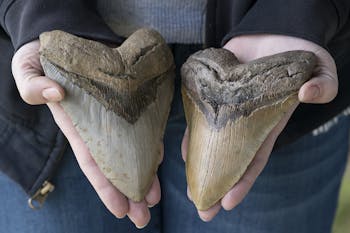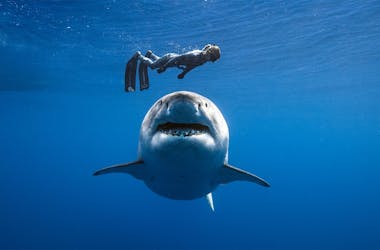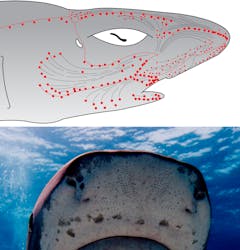Shark Week at Divers Direct

As ocean divers, we’re bound to encounter sharks at some point. Whereas having a healthy respect for these apex predators is good, being afraid of them can lead to... well... doing everything you’re not supposed to do in diving (aka panicking underwater).
If you’ve never had the pleasure of diving with sharks, you’re missing out on an enriching and educational experience. It can be calming to know that these creatures often behave differently on a shark dive than they do in other environments. How is that possible? Well, much like animals living in captivity or near urban areas, the sharks that live in areas where there are daily shark dives get used to being around divers and often put on a show. However, when you encounter a shark (or several) on a wreck or reef dive, they don’t tend to want you approaching them and they might see your eager approach as a threat. Remember that you’re diving into their world, so always give them the space and respect they deserve.

With over 500 species of sharks, there’s a lot to learn about these ocean dwellers. And though they all possess similar attributes and characteristics, they’re as different amongst each other as we are.
How long have sharks been around?
Scientists believe that sharks have been around for about 455 million years (based on fossil scales that have been uncovered). Of the over 500 species, over 140 species of sharks are under threat and classified from ‘vulnerable’ to ‘critically endangered’.
Why are sharks important?
There are several reasons that sharks are important. And all those reasons point to the fact that the health of our oceans depends on them. First, sharks help to maintain the balance of our ocean ecosystems. While the predators help with population control, the bottom feeders and clean up crew work to keep our oceans clean. This contributes to the overall health of the oceans.
Additionally, sharks can act as effective carbon sinks - a phenomenon that happens when they die and they sink to the bottom of the ocean. This is beneficial to us because most of the carbon and carbon dioxide in their bodies remains at the bottom of the sea with them rather than being released into the atmosphere and the air we breathe. This is true of nearly all ocean creatures, and the larger the creature, the more carbon dioxide is kept out of the atmosphere.
Finally, sharks help to move key nutrients for other ocean dwellers due to how they live. Their migration patterns as well as their travels between the depths and surface allows these nutrients to travel along with them and move through the ocean. If all those other sea dwellers couldn’t get these key nutrients, the impact could be devastating to life above and below the surface. Sharks help to keep a balance in the food chain.
All of these factors play into why we need sharks and why they need to be protected.
What about those shark teeth?

Note that not all sharks have the same teeth. Some have pointy narrow teeth while others have triangular, serrated teeth. Additionally, some have one row of teeth while other species have multiple rows. Unlike humans, sharks lose and grow new teeth (thousands of them) all the time. Some species will grow (and lose) around 35,000 teeth in their lifetime. This is why it’s relatively easy to find shark teeth on the beach and the ocean floor.
And though a Great White shark’s bite is equivalent to about 4,000 pounds per square inch (OUCH!), you’re more likely to be killed by a champagne cork than a shark.
Do sharks lay eggs?
Yes and no. While some shark species lay eggs, others give birth much like humans do. Interestingly, the ones who lay eggs don’t stick around to care for them so they’re on their own before they even hatch.
How do scientists know how old sharks are?
Scientists count the shark’s vertebrae, kind of like counting the rings of a tree trunk to determine its age. Since sharks don’t have bones, their vertebrae are made up of concentric pairs of cartilage or opaque, translucent bands. Though it sounds simple, scientists have to keep up to date on each species to determine how often these band pairs form so they are aging the sharks correctly. Oddly enough, how often the band pairs form can change over time. Scientists work to validate the actual rate of the bands forming for each species so they can get as close as possible to the shark’s age.
Do sharks have a sixth sense?
Yes. The ampullae of Lorenzini are located within sharks’ head (they’re the little black dots you often see just about their mouth) and are used to sense the electric fields created by other animals in the water. This ‘sixth sense’ allows them to hone in on their prey and attack. These special electroreceptor organs also allow sharks to sense temperature shifts in the ocean. It’s all about survival.
In summary
These weird and wonderful creatures live in most ocean environments, from warm tropical climates to under the arctic ice. Did you know that the smallest shark (dwarf lantern shark) is about the size of your hand and the largest (whale shark) is about 39 feet long and is actually the largest fish in the sea? Varying dramatically in size, sharks are key to healthy oceans and a healthy planet.






